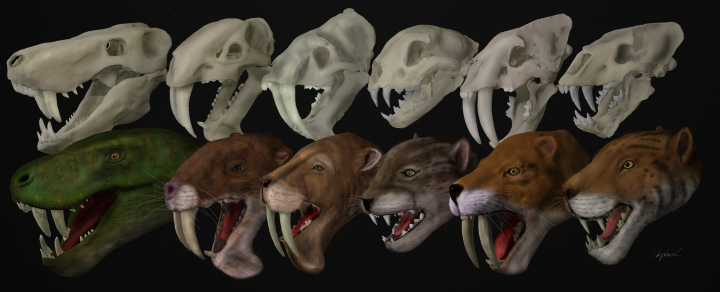
Sabre-toothed predators evolved an unknown diversity in hunting and killing styles over the last 250 million years, a new study reveals.
Sabretooth cats are among the most iconic fossils, but sabre-toothed animals came in all shapes and sizes and nearly a hundred different species are known to science so far. Not all them belonged to the same family as modern cats and some of them even predate dinosaurs.
Elongated canine teeth, reaching a length of up to 30 cm in some species, evolved independently in seven different evolutionary lines of carnivorous animals. Due to similar skull and tooth shape, it had long been assumed that all of these animals hunted and killed prey in the same manner. This assumption has now been refuted by a new study, published today in Proceedings of the Royal Society B.
An international team of scientists from the UK, Spain and Germany examined over 60 different sabretooth species. Using computer simulations, the team investigated the functional capabilities of the teeth and skulls, such as calculating bite forces and bending strength,
Dr Stephan Lautenschlager, lead author and Lecturer for Palaeobiology at the University of Birmingham, commented: “It is fascinating to see that so many different species have evolved elongated canine teeth to subdue prey, but our results show that they used these sabre-like teeth differently to do so.
The study revealed that sabre-toothed animals may have looked very similar, but they used their teeth in different ways. Some species had specialised on hunting small prey using the canine teeth to inflict deep wounds. Other species were likely pack hunters specialising on large prey with reinforced bone structures to stabilise the jaws.
Dr Lautenschlager added: “We know that different sabre-tooth species shared the same ecosystem. Using computational methods, we can show that their specialisation on different prey allowed them co-exist and to avoid competition.”
- For more information, interviews or embargoed copies of the research paper, please contact Tony Moran, International Communications Manager, University of Birmingham on +44 (0)782 783 2312. For out-of-hours enquiries, please call +44 (0) 7789 921 165.
- The University of Birmingham is ranked amongst the world’s top 100 institutions, its work brings people from across the world to Birmingham, including researchers and teachers and more than 6,500 international students from over 150 countries.